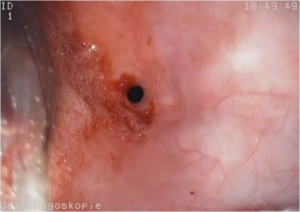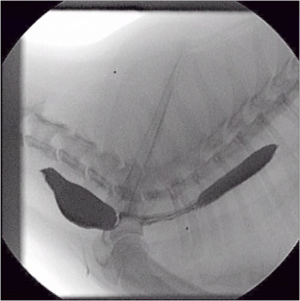Difference between revisions of "Oesophageal Stricture"
TestStudent (talk | contribs) |
|||
| (31 intermediate revisions by 4 users not shown) | |||
| Line 1: | Line 1: | ||
| − | {{ | + | {{review}} |
| − | == | + | |
| − | + | {{cat}} | |
| − | + | {{dog}} | |
| − | * | + | |
| − | + | ==Typical Signalment== | |
| − | + | *Any age group can be affected | |
| − | + | *Animals with [[Oesophagitis - WikiClinical|oesophagitis]] | |
| − | * | + | *Young animals with congenital [[Hiatal Hernia - WikiClinical|hiatal hernias]] |
| − | + | *Poor positioning during [[Anaesthesia|anaesthesia]] | |
| − | |||
| − | |||
| − | |||
| − | == | + | ==Description== |
| − | + | An oesophageal stricture is an abnormal circumferential narrowing of the lumen secondary to severe [[Oesophagitis - WikiClinical|oesophagitis]]. A deep wall injury results followed by healing by fibrosis. The most important causes are: | |
| + | *Chemical injury from swallowed substances | ||
| + | *Gastro-oesophageal reflux | ||
| + | *[[Oesophageal Foreign bodies|Foreign bodies]] | ||
| + | *Oesophageal surgery | ||
| + | *[[Oesophageal Neoplasia - WikiClinical|Neoplasia]] | ||
| + | *Oesophageal abscesses | ||
==Diagnosis== | ==Diagnosis== | ||
| + | |||
===Clinical Signs=== | ===Clinical Signs=== | ||
| − | + | Depend on the severity and extent of the stricture but include: | |
| − | * | + | *Regurgitation shortly after feeding (may then attempt to re-ingest the regurgitant) |
| − | * | + | *Anorexia |
| − | * | + | *Weight loss |
| + | [[Image:Oesophageal Stricture.png|thumb|right|300px|Oesophageal Stricture Oesophagoscopy - Copyright David Walker RVC]] | ||
| + | [[Image:Oesophageal Stricture Flouroscopy.png|thumb|right|300px|Oesophageal Stricture Flouroscopy - Copyright David Walker RVC]] | ||
| + | *Malnutrition | ||
| + | *Ptyalism | ||
| + | *Aspiration pneumonia (with associated pulmonary signs such as wheezing and crackling on lung auscultation) | ||
| + | *Liquid food better tolerated than solid food. | ||
===Diagnostic Imaging=== | ===Diagnostic Imaging=== | ||
| − | + | Fibrosing strictures must be differentiated from vascular ring anomalies, oesophagitis, intraluminal and extraluminal masses. This can be done with survey and contrast radiography, endoscopy and ultrasonography. | |
| − | Fibrosing strictures must be differentiated from | ||
| − | + | Survey radiographs are usually unremarkable in animals with benign oesophageal strictures. Barium contrast radiography is normally diagnostic of the disorder and may demonstrate: | |
| + | *Segmental or diffuse narrowing of the oesophagus | ||
| + | *Oesphageal dilatation proximal to the site of the stricture | ||
| − | + | Ultrasonography is not usually useful in diagnosing small benign strictures but may visualise those caused by mass compression. | |
| − | + | Oesophagoscopy is used for a definitive diagnosis. It should be used to confirm the site and severity of the stricture and also to exclude the presence of an intraluminal mass. | |
| − | |||
| − | |||
==Treatment== | ==Treatment== | ||
| − | |||
| − | |||
| − | |||
| − | |||
| − | |||
| − | |||
| − | |||
| − | |||
| − | |||
| − | |||
| − | |||
| − | |||
| − | + | The suspected cause (ie.Oesphagitis)should be corrected first. | |
| + | Oral feedings should be withdrawn in patients with severe stricture or oesophagitis. An oesophagostomy tube may be placed in these cases to provide nutritional support. | ||
| − | + | Medical therapies: | |
| + | *Oral sucralfate | ||
| + | *Gastric acid secretory inhibitors (cimetidine, ranitidine, omeprazole) | ||
| + | *Anti-inflammatory doses of corticosteroids (prednisolone) to prevent fibrosis and re-stricture. | ||
| − | + | Surgical therapies: | |
| + | *Dilation/widening of the stricture by ballooning or bougienage. | ||
| + | *Surgical resection is not recommended because iatrogenic strictures at the anastomotic site are possible. | ||
==Prognosis== | ==Prognosis== | ||
| − | The shorter the length of oesophagus involved and the quicker the corrective procedure is performed | + | The shorter the length of oesophagus involved and the quicker the corrective procedure is performed the better the prognosis. |
| − | + | Animals with large, mature strictures and those with continued oesophagitis have a guarded prognosis. Long term gastrostomy tubes may be required in some cases. | |
| − | |||
| − | |||
| − | |||
| − | |||
==References== | ==References== | ||
*Hall, E.J, Simpson, J.W. and Williams, D.A. (2005) '''BSAVA Manual of Canine and Feline Gastroenterology (2nd Edition)''' ''BSAVA'' | *Hall, E.J, Simpson, J.W. and Williams, D.A. (2005) '''BSAVA Manual of Canine and Feline Gastroenterology (2nd Edition)''' ''BSAVA'' | ||
| − | |||
| − | |||
| + | *Merck & Co (2008) '''The Merck Veterinary Manual''' | ||
| − | + | *Nelson, R.W. and Couto, C.G. (2009) '''Small Animal Internal Medicine (Fourth Edition)''' ''Mosby Elsevier''. | |
| − | |||
| − | |||
| − | |||
| − | |||
| − | |||
| − | |||
Revision as of 09:27, 21 August 2009
| This article has been peer reviewed but is awaiting expert review. If you would like to help with this, please see more information about expert reviewing. |
Typical Signalment
- Any age group can be affected
- Animals with oesophagitis
- Young animals with congenital hiatal hernias
- Poor positioning during anaesthesia
Description
An oesophageal stricture is an abnormal circumferential narrowing of the lumen secondary to severe oesophagitis. A deep wall injury results followed by healing by fibrosis. The most important causes are:
- Chemical injury from swallowed substances
- Gastro-oesophageal reflux
- Foreign bodies
- Oesophageal surgery
- Neoplasia
- Oesophageal abscesses
Diagnosis
Clinical Signs
Depend on the severity and extent of the stricture but include:
- Regurgitation shortly after feeding (may then attempt to re-ingest the regurgitant)
- Anorexia
- Weight loss
- Malnutrition
- Ptyalism
- Aspiration pneumonia (with associated pulmonary signs such as wheezing and crackling on lung auscultation)
- Liquid food better tolerated than solid food.
Diagnostic Imaging
Fibrosing strictures must be differentiated from vascular ring anomalies, oesophagitis, intraluminal and extraluminal masses. This can be done with survey and contrast radiography, endoscopy and ultrasonography.
Survey radiographs are usually unremarkable in animals with benign oesophageal strictures. Barium contrast radiography is normally diagnostic of the disorder and may demonstrate:
- Segmental or diffuse narrowing of the oesophagus
- Oesphageal dilatation proximal to the site of the stricture
Ultrasonography is not usually useful in diagnosing small benign strictures but may visualise those caused by mass compression.
Oesophagoscopy is used for a definitive diagnosis. It should be used to confirm the site and severity of the stricture and also to exclude the presence of an intraluminal mass.
Treatment
The suspected cause (ie.Oesphagitis)should be corrected first. Oral feedings should be withdrawn in patients with severe stricture or oesophagitis. An oesophagostomy tube may be placed in these cases to provide nutritional support.
Medical therapies:
- Oral sucralfate
- Gastric acid secretory inhibitors (cimetidine, ranitidine, omeprazole)
- Anti-inflammatory doses of corticosteroids (prednisolone) to prevent fibrosis and re-stricture.
Surgical therapies:
- Dilation/widening of the stricture by ballooning or bougienage.
- Surgical resection is not recommended because iatrogenic strictures at the anastomotic site are possible.
Prognosis
The shorter the length of oesophagus involved and the quicker the corrective procedure is performed the better the prognosis. Animals with large, mature strictures and those with continued oesophagitis have a guarded prognosis. Long term gastrostomy tubes may be required in some cases.
References
- Hall, E.J, Simpson, J.W. and Williams, D.A. (2005) BSAVA Manual of Canine and Feline Gastroenterology (2nd Edition) BSAVA
- Merck & Co (2008) The Merck Veterinary Manual
- Nelson, R.W. and Couto, C.G. (2009) Small Animal Internal Medicine (Fourth Edition) Mosby Elsevier.

